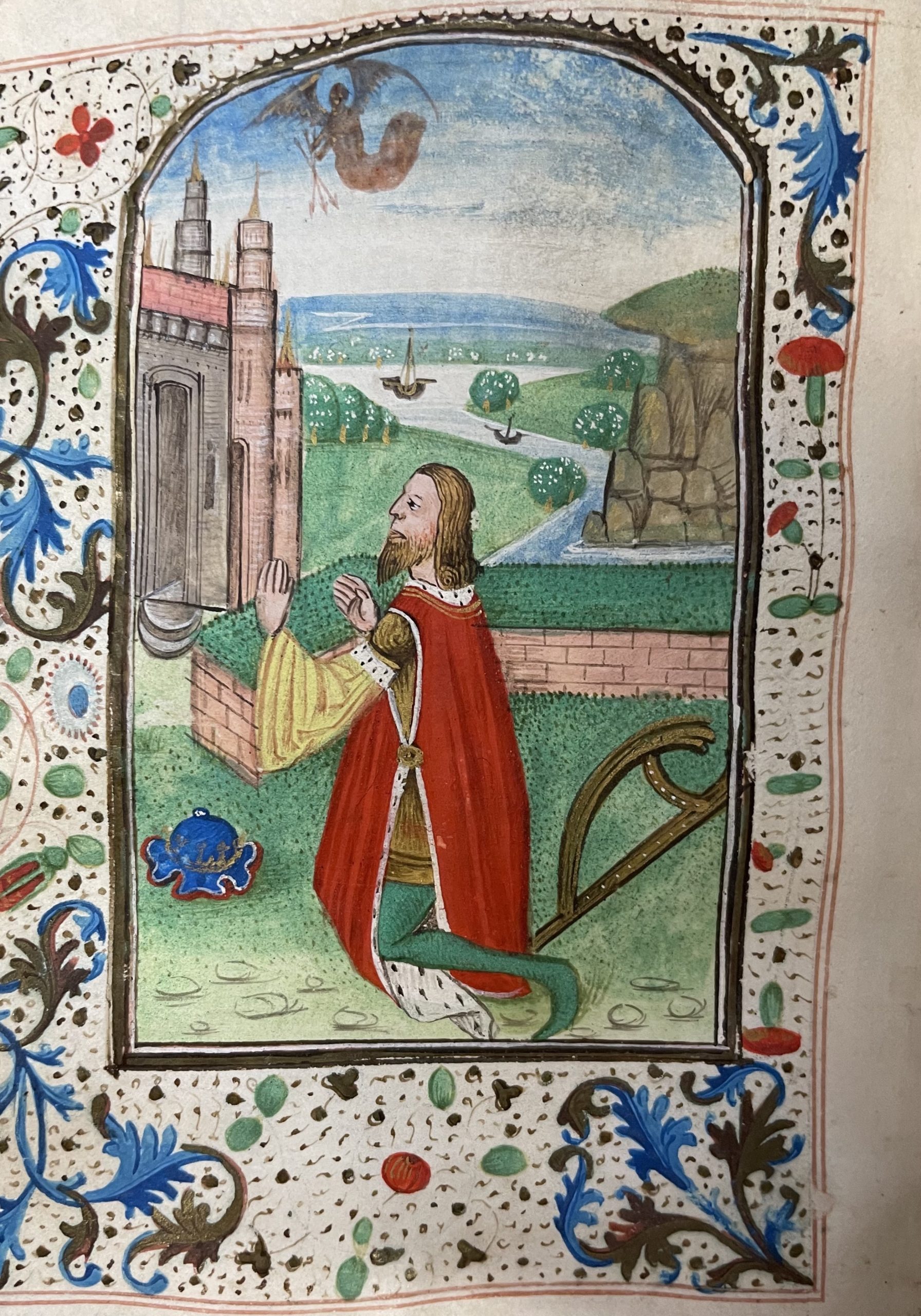King David is my favorite Old Testament man, so naturally, after flipping through Les Enluminures’ Dutch Book of Hours, it was impossible for me to forget the strange figure floating above King David in the miniature preceding the Penitential Psalms. My team had many conjectures (was it a demon, an afterthought, an angel?), and I had to know the truth. Who is messing with David?
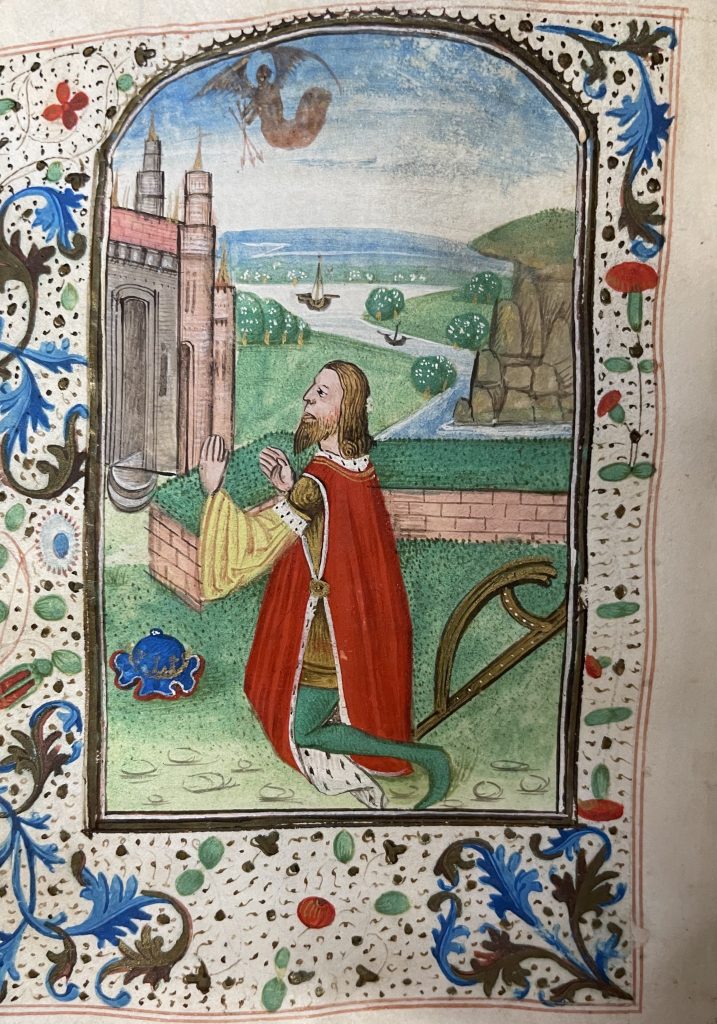
(Les Enluminures, BOH 0159, fol. 72v, https://www.lesenluminures.com/artworks/categories/5/9559-book-of-hours-use-of-rome-c.-1480).

Before I map out my curvy research path, I want to discuss the assumptions I carried with me into this project. Because the David miniature introduced the Penitential Psalms section which directs its readers (typically laypeople) toward prayers of repentance, I added David and repentance together in my brain to the result of one answer: Bathsheba. I assumed that the BOH illuminators would depict what is, in my opinion, the most popular story of repentance in the Old Testament—the one where David repents for committing adultery with Bathsheba and murdering her husband Uriah. A feature like that would make sense in this Book of Hours section, so as I embarked on my research quest, I expected Adultery Story-related answers about this figure in the sky.
I dove into the Morgan Library’s online collection of Medieval & Renaissance Manuscripts, and images of King David on his knees talking to someone in the sky flooded my screen. Not to my surprise, that someone in the sky was never a watery brown color nor unrecognizable; if there was a figure in the sky, it was almost always God or Jesus emerging from heaven. Most of them looked like this:
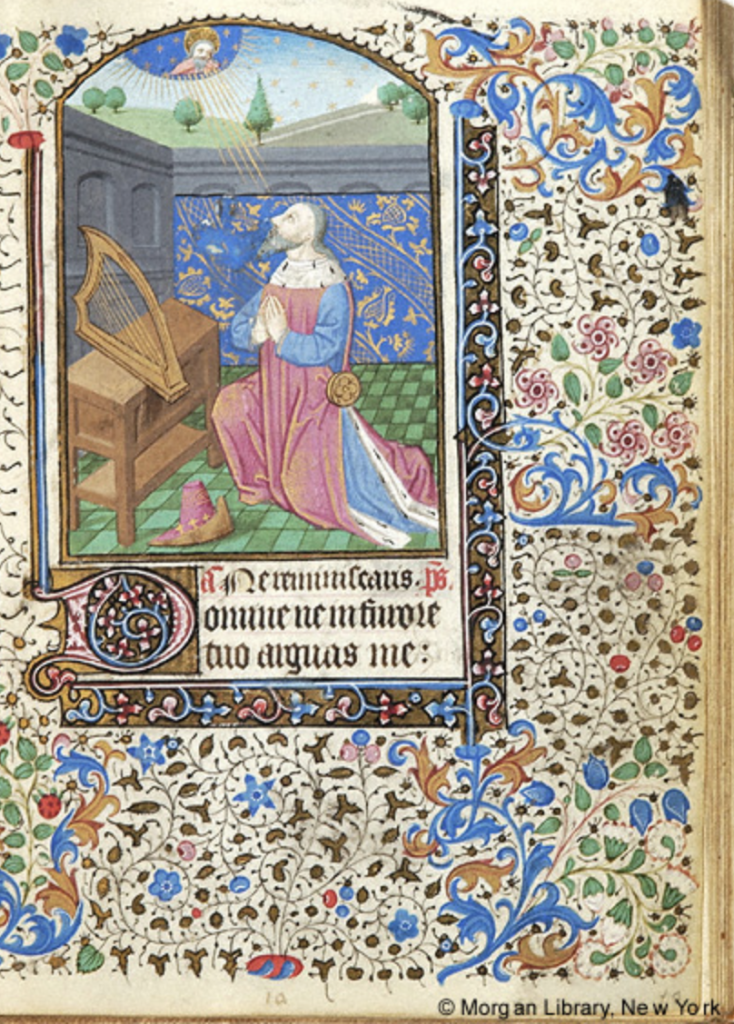
(New York City, Morgan Library, MS M. 169, fol. 76r, http://ica.themorgan.org/manuscript/page/10/77138).
I found very little evidence of angels and David in the same miniature. If God or Jesus were not in the sky, usually nothing was. This non-discovery only fueled my research flame. I concluded that:
1. We weren’t crazy for thinking the floating figure was, um, really strange and
2. Because I found such variation, there were probably other repentant-David stories for medieval illuminators to choose from. It was time to crack open the secondary sources and search for what those options were.
Miraculously the first secondary source I read, an article by Margareth Owens titled “The Image of King David in Prayer in Fifteenth-Century Books of Hours,” immediately answered my initial questions. She associated the God/Jesus-in-the-sky images with the Adultery Story which confirmed my assumption about its medieval trendiness.
Then she blew my mind: “Accounts of the second occasion when David sinned are contained in 2 Samuel, chapter 24, and in 1 Chronicles, chapter 21. These passages describe how David was guilty of the sin of pride in demanding a census of Israel and Judah; how the prophet Gad was sent by God to rebuke David; and how David repented and was offered the choice among three punishments: famine, war, or pestilence. The choice offered David was represented in early illuminated manuscripts as an angel who offers David three arrows or three different objects—often a skull, a sword, and a scourge—symbolizing the three punishments” (Owens, 27). There was a second option, and our miniature was totally in on it. Thanks to Margareth Owens, it was safe to say that the strange guy hovering over David was an angel, and not just any angel, an angel displaying David’s three punishment options.
My question at this point evolved from “what?” to “why?”. Why choose what I presume to be the less popular Census Story over the juicy Adultery Story? I had to find out, but first, I wanted to read 2 Samuel 24 and 1 Chronicles 21 to gather my own understanding of this Census Story.
A few things stood out to me after I read both chapters. First of all, the three options are presented to King David by a human prophet named Gad, not an angel. Second, in both versions of the story, David actually sees an angel on the verge of executing the punishment option he chose.
So was that being in the sky of this miniature the angel David sees or some misrepresentation of Gad?
Charles Huttar’s “Frail Grass and Firm Tree: David as a Model of Repentance in the Middle Ages and Early Renaissance” implies that the answer is the latter. Huttar revealed a historical connection between the angel and Gad: “The prominence of an angel in the [Census Story] may also be compared with the displacement of Nathan by an angel in some medieval accounts of the [Adultery Story …] The Lord had Gad offer David three possible punishments, […] but a common artistic portrayal was an angel in the clouds, holding […] David’s three options,” (Huttar, 46). This means if iconographies of prophets and angels were confused at times, the angel really could be some version of Gad.
With all of that information in my head, I was better prepared for my second browse through the Morgan Library’s manuscript collection. I found five miniatures with similar arrow/angel iconographies, and I finally exhaled, grateful to know that our illuminator wasn’t completely crazy. Below is my favorite of the five which is undoubtedly the Census Story.
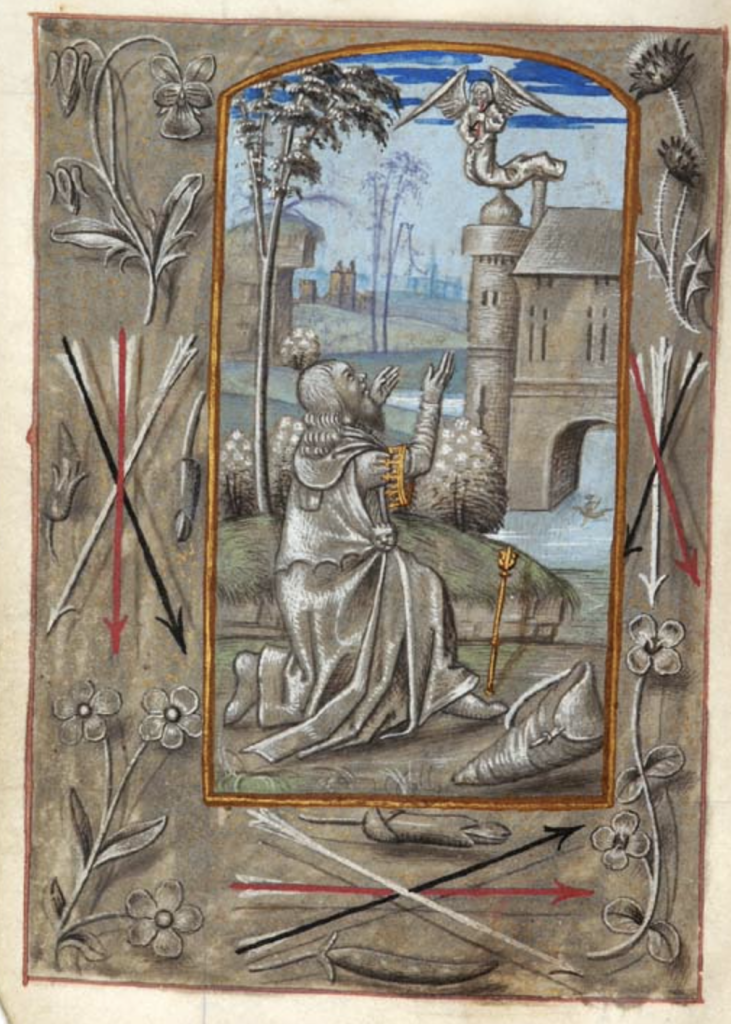
(New York City, Morgan Library, MS M.33, fol. 150v, http://ica.themorgan.org/manuscript/page/22/76901)
I never found anything close to the creepiness of the angel in BOH 0159, but this arrow-bearing angel was similar in vagueness:
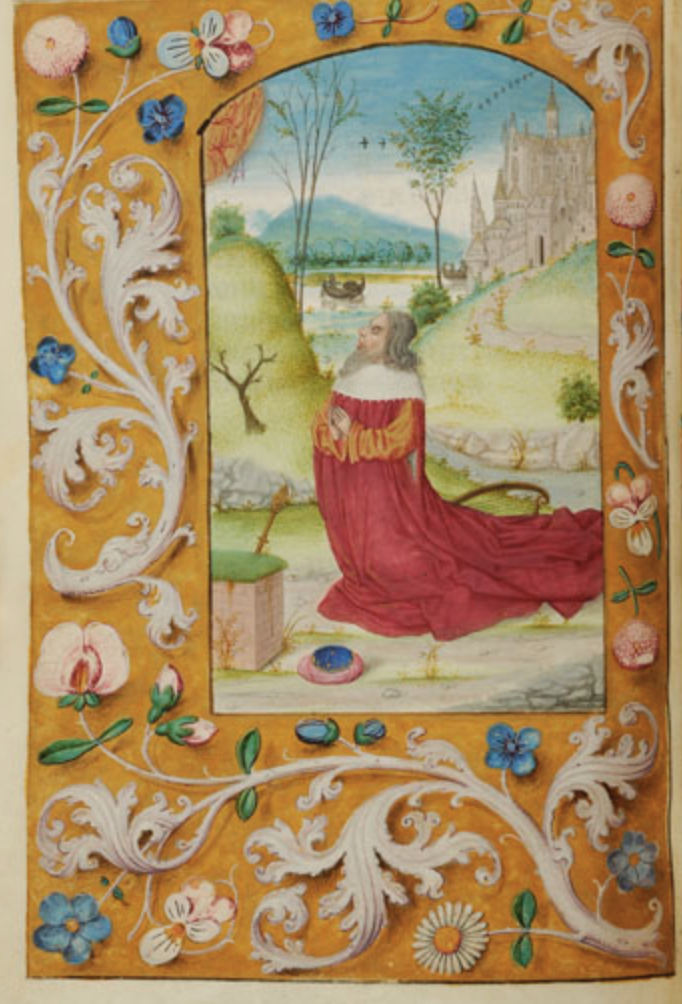
(New York City, Morgan Library, MS M.1170, fol. 059v, http://ica.themorgan.org/manuscript/page/18/282722)
Finding those miniatures was reassuring, but I still wondered why the Census Story was chosen over the Adultery Story. I decided to see what biblical scholar Thomas Karimundackal had to offer me in his article, “When the king crosses the line: the figure of David in 2 Samuel 24 part II.” What I learned expanded my thoughts about this miniature to how it relates to the Book of Hours genre as a whole, not just the Penitential Psalms, and it also provided a possible answer to my “why” question. He underscores a fundamental difference between the Adultery Story and the Census Story: “In exposing the falsehood of David’s sin, Nathan [the prophet in the Adultery Story] used logic and reason to persuade David of his guilt. However, in the census narrative, David becomes aware of his sinfulness by himself” (Karimundackal, 27).
I immediately connected the “by himself” aspect of the Census Story to the personal aspect of Books of Hours. Maybe this Census Story was chosen over the Adultery Story because David came to repentance on his own. I thought about how priests acted as intermediaries between God and man, especially when it came to repentance, and to me, the Adultery Story’s Nathan was like those priests. Books of Hours, though, bolstered a layperson’s ability to come to repentance on his/her own, like David in the Census Story. If that was an intentional choice, I really liked the subtlety.
That’s where I ended my research journey, one I consider a great success. No longer will that angel loom, to our fright, above David, for he has an origin story, collected by me. Now I can assuredly tell King David, “Not to worry! The figure looming above you is just an angel bringing the punishment for your sin on all of Israel.”
Works Consulted
The Bible. English Standard Version, YouVersion, www.youversion.com.
Huttar, Charles. “Frail Grass and Firm Tree: David as a Model of Repentance in the
Middle Ages and Early Renaissance.” The David Myth in Western Literature, edited by Raymond-Jean Fronton and Jan Wojcik, Purdue University Press, 1980, pp. 38-54.
Karimundackal, Thomas. “When the king crosses the line: the figure of David in 2 Samuel 24 part II.” Vidyajyoti, Vol. 82, Issue 6, 2018, pp. 423-438.
Les Enluminures, BOH 0159, https://www.lesenluminures.com/artworks/categories/5/9559-book-of-hours-use-of-rome-c.-1480/
New York City, Morgan Library, MS M.33, fol. 150v, http://ica.themorgan.org/manuscript/page/22/76901
New York City, Morgan Library, MS M. 169, fol.76r, http://ica.themorgan.org/manuscript/page/10/77138
New York City, Morgan Library, MS M.1170, fol. 059v, http://ica.themorgan.org/manuscript/page/18/282722
Owens, Margareth Boyer. “The image of King David in prayer in fifteenth-century Books of Hours.” Imago Musicae, Vol. 6, 1989, pp. 23-28.
